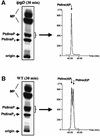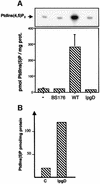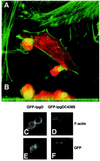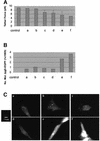Conversion of PtdIns(4,5)P(2) into PtdIns(5)P by the S.flexneri effector IpgD reorganizes host cell morphology
- PMID: 12356723
- PMCID: PMC129044
- DOI: 10.1093/emboj/cdf522
Conversion of PtdIns(4,5)P(2) into PtdIns(5)P by the S.flexneri effector IpgD reorganizes host cell morphology
Abstract
Phosphoinositides play a central role in the control of several cellular events including actin cytoskeleton organization. Here we show that, upon infection of epithelial cells with the Gram-negative pathogen Shigella flexneri, the virulence factor IpgD is translocated directly into eukaryotic cells and acts as a potent inositol 4-phosphatase that specifically dephosphorylates phosphatidylinositol 4,5-bisphosphate [PtdIns(4,5)P(2)] into phosphatidylinositol 5-monophosphate [PtdIns(5)P] that then accumulates. Transfection experiments indicate that the transformation of PtdIns(4,5)P(2) into PtdIns(5)P by IpgD is responsible for dramatic morphological changes of the host cell, leading to a decrease in membrane tether force associated with membrane blebbing and actin filament remodelling. These data provide the molecular basis for a new mechanism employed by a pathogenic bacterium to promote membrane ruffling at the entry site.
Figures








Similar articles
-
PtdIns5P activates the host cell PI3-kinase/Akt pathway during Shigella flexneri infection.EMBO J. 2006 Mar 8;25(5):1024-34. doi: 10.1038/sj.emboj.7601001. Epub 2006 Feb 16. EMBO J. 2006. PMID: 16482216 Free PMC article.
-
Shigella flexneri regulation of ARF6 activation during bacterial entry via an IpgD-mediated positive feedback loop.mBio. 2015 Mar 3;6(2):e02584. doi: 10.1128/mBio.02584-14. mBio. 2015. PMID: 25736891 Free PMC article.
-
The type 3 secretion effector IpgD promotes S. flexneri dissemination.PLoS Pathog. 2022 Feb 7;18(2):e1010324. doi: 10.1371/journal.ppat.1010324. eCollection 2022 Feb. PLoS Pathog. 2022. PMID: 35130324 Free PMC article.
-
Regulation of phosphatidylinositol 4,5-bisphosphate levels and its roles in cytoskeletal re-organization and malignant transformation.Chem Phys Lipids. 1999 Apr;98(1-2):13-22. doi: 10.1016/s0009-3084(99)00014-6. Chem Phys Lipids. 1999. PMID: 10358924 Review.
-
Modification of phosphoinositides by the Shigella effector IpgD during host cell infection.Front Cell Infect Microbiol. 2022 Oct 27;12:1012533. doi: 10.3389/fcimb.2022.1012533. eCollection 2022. Front Cell Infect Microbiol. 2022. PMID: 36389142 Free PMC article. Review.
Cited by
-
The Tomato Defensin TPP3 Binds Phosphatidylinositol (4,5)-Bisphosphate via a Conserved Dimeric Cationic Grip Conformation To Mediate Cell Lysis.Mol Cell Biol. 2015 Jun 1;35(11):1964-78. doi: 10.1128/MCB.00282-15. Epub 2015 Mar 23. Mol Cell Biol. 2015. PMID: 25802281 Free PMC article.
-
PtdIns5P: news and views of its appearance, disappearance and deeds.Arch Biochem Biophys. 2013 Oct 15;538(2):171-80. doi: 10.1016/j.abb.2013.07.023. Epub 2013 Aug 2. Arch Biochem Biophys. 2013. PMID: 23916588 Free PMC article. Review.
-
Alteration of epithelial structure and function associated with PtdIns(4,5)P2 degradation by a bacterial phosphatase.J Gen Physiol. 2007 Apr;129(4):267-83. doi: 10.1085/jgp.200609656. J Gen Physiol. 2007. PMID: 17389247 Free PMC article.
-
The phosphatidylinositol (PI)-5-phosphate 4-kinase type II enzyme controls insulin signaling by regulating PI-3,4,5-trisphosphate degradation.Proc Natl Acad Sci U S A. 2003 Aug 19;100(17):9867-72. doi: 10.1073/pnas.1734038100. Epub 2003 Aug 1. Proc Natl Acad Sci U S A. 2003. PMID: 12897244 Free PMC article.
-
Targeting of the hydrophobic metabolome by pathogens.Traffic. 2015 May;16(5):439-60. doi: 10.1111/tra.12280. Traffic. 2015. PMID: 25754025 Free PMC article. Review.
References
-
- Bligh E.G. and Dyer,W.J. (1959) A rapid method of total lipid extraction and purification. Can. J. Biochem. Physiol., 37, 911–919. - PubMed
-
- Blondeau F., Laporte,J., Bodin,S., Superti-Furga,G., Payrastre,B. and Mandel,J.L. (2000) Myotubularin, a phosphatase deficient in myotubular myopathy, acts on phosphatidylinositol 3-kinase and phosphatidylinositol 3-phosphate pathway. Hum. Mol. Genet., 9, 2223–2229. - PubMed
Publication types
MeSH terms
Substances
LinkOut - more resources
Full Text Sources
Other Literature Sources
Molecular Biology Databases

